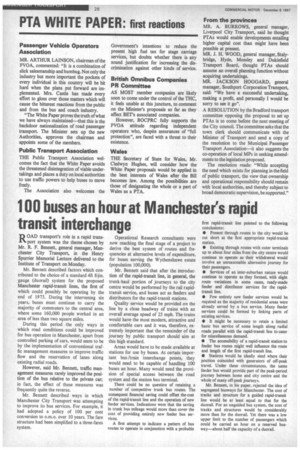100 buses an hour at Manchester's rapid transit interchange
Page 28

If you've noticed an error in this article please click here to report it so we can fix it.
D OAD transport's role in a rapid trans-1-1,-port system was the theme chosen by Mr. R. F. Bennett, general manager, Manchester City Transport, in the Henry Spurrier Memorial Lecture delivered to the Institute of Transport on Monday.
Mr. Bennett described factors which contributed to the choice of a standard 4ft 8tin. gauge (duorail) system for the proposed Manchester rapid-transit lines, the first of which could possibly be operating by the end of 1973. During the intervening six years, buses must continue to carry the majority of commuters to the central area, where some 160,000 people worked in an area of less than two square miles.
During this period the only ways in which road conditions could be improved for bus operation in Manchester, apart from controlled parking of cars, would seem to be by the implementation of conventional traffic management measures to improve traffic flow and the reservation of lanes along existing radial roads.
However, said Mr. Bennett, traffic management measures rarely improved the position of the bus relative to the private car, in fact, the effect of these measures was frequently quite the reverse.
Mr. Bennett described ways in which Manchester City Transport was attempting to improve its bus services. For example, it had adopted a policy of 100 per cent conversion to o.m.o. over 10 years. The fare structure had been simplified to a three-fares system. Operational Research consultants were now reaching the final stage of a project to derive the best system of routes and frequencies at alternative levels of expenditure, for buses serving the Wythenshawe estate (population 100,000).
Mr. Bennett said that after the introduction of the rapid-transit line, in general, the trunk-haul portion of journeys to the city centre would be performed by the rail rapidtransit service, and buses act as feeders and distributors for the rapid-transit stations.
Quality service would be provided on the line by a close headway of trains with an overall average speed of 25 mph. The trains would have the most modern, attractive and comfortable cars and it was, therefore, extremely important that the remainder of the journey by public transport should aim at this high standard.
Areas would have to be made available at stations for use by buses. At certain important bus /train interchange points, they would need to be capable of handling 100 buses an hour. Many would need the provision of special access between the road system and the station bus terminal.
There could be no question of retaining a number of competitive trunk bus routes. The consequent financial saving could offset the cost of the rapid-transit line and the operation of new feeder services. Indications were that the saving in trunk bus mileage would more than cover the cost of providing entirely new feeder bus services.
A first attempt to indicate a pattern of bus routes to operate in conjunction with a probable first rapid-transit line pointed to the following conclusions: • Present through routes to the city would be cut short at the first appropriate rapid-transit stat ion.
• Existing through routes with outer terminals up to about four miles from the city centre would continue to operate as their withdrawal would involve an unreasonable alternative journey for their passengers.
• Services of an inter-suburban nature would continue to operate as they formed, with slight route variations in some cases, ready-made feeder and distributor services for the rapidtransit line.
• Few entirely new feeder services would be required as the majority of residential areas were already served by a bus service. Many feeder services could be formed by linking parts of existing services.
• It might be necessary to retain a limited basic bus service of some length along radial roads parallel with the rapid-transit line to cater for miscellaneous demand.
• The accessibility of a rapid-transit station to feeder bus routes might well influence the route and length of the first rapid-transit line.
• Stations would be ideally sited where their position coincided with generators of off-peak travel. Under these circumstances, the same feeder bus would provide part of the peak-period journey between home and city centre and the whole of many off-peak journeys.
Mr. Bennett, in his paper, rejected the idea of segregated busways for Manchester. The cost of tracks and structure for a guided rapid-transit line would be at least equal to that for the duorail. For an unguided bus system, the cost of tracks and structures would be considerably more than for the duorail. Yet there was a low upper limit to the number of passengers which could be carried an hour on a reserved busway—about half the capacity of a duorail.








































































































